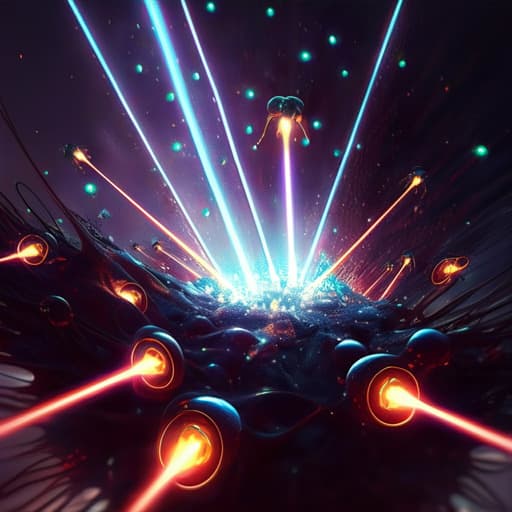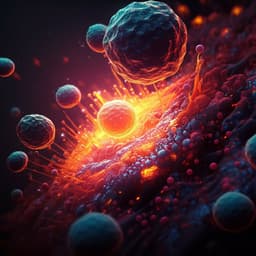
Medicine and Health
CAR-cell therapy in the era of solid tumor treatment: current challenges and emerging therapeutic advances
K. M. Maalej, M. Merhi, et al.
This review by leading researchers discusses the potential of CAR-T, CAR-NK, and CAR-M cell therapies in combating solid tumors while addressing the significant challenges these therapies face. Discover innovative strategies being explored to enhance effectiveness and the promising advantages of alternative immune cells.
~3 min • Beginner • English
Introduction
The paper frames cancer as a major global health burden where conventional modalities (surgery, radiotherapy, chemotherapy) often fail in metastatic or recurrent settings. Advances in immuno-oncology have enabled engineered immune-cell therapies, notably chimeric antigen receptor (CAR) approaches that redirect effector cells to tumor-associated antigens in an MHC-independent manner. CAR-T therapy has achieved major successes in hematologic malignancies targeting CD19 and BCMA, with complete remission rates up to 85–100% in acute lymphoblastic leukemia and 29–60% in multiple myeloma. These results motivate translation to solid tumors, where numerous trials are ongoing. However, solid tumors pose unique barriers: poor trafficking and infiltration, antigen heterogeneity and loss, abnormal chemokine milieus, and immunosuppressive tumor microenvironments, as well as toxicities such as on-target/off-tumor effects and cytokine release syndrome. The review discusses current applications, challenges, and innovations for CAR-T, and highlights alternative CAR platforms using NK cells (CAR-NK) and macrophages (CAR-M) that may address some limitations in solid tumors.
Literature Review
Methodology
Key Findings
- Hematologic benchmarks: Anti-BCMA CAR-T trials in relapsed/refractory multiple myeloma reported complete remission rates of 29–60% in 61 patients; CD19 CAR-T achieved initial complete remission up to 85% in ALL and up to 100% in refractory/relapsed B-ALL. CAR-T is approved for several B-cell lymphomas and myeloma.
- Solid tumor CAR-T clinical signals by target:
• IL-13Rα2 (GBM): Multi-dose CAR-T induced complete regression for ~8 months in one disseminated GBM patient (NCT02208362); another trial in 3 recurrent GBM patients showed tolerability with limited remission, with antigen loss implicated in relapse (NCT00730613).
• GD2: In H3K27M-mutant diffuse midline gliomas, 3/4 patients showed clinical/radiographic improvements without on-target/off-tumor toxicity (NCT04196413). In neuroblastoma, 3/11 complete remissions (NCT00085930). In metastatic melanoma, GD2 CAR-T induced LAG-3/PD-1 upregulation, suggesting benefit from checkpoint blockade.
• ROR1: Phase I in lung/breast cancers showed mixed responses with reduced burden at some sites in 4/5 patients (NCT02706392).
• EGFR/EGFRvIII: In EGFR+ r/r NSCLC (n=11), 2 partial responses, 5 stable diseases without severe toxicity (NCT01869166). In EGFRvIII+ GBM (n=10), median OS ~8 months with on-target activity (NCT02209376). piggyBac EGFR-CAR-T in NSCLC (n=9) yielded 1 sustained response >13 months, 6 SD; median PFS 7.13 months, OS 15.63 months (NCT03182816).
• CEA: Metastatic CRC dose-escalation trial (n=10) achieved 7 SD up to 30 weeks and 2 tumor reductions without severe AEs (NCT02349724). Liver metastasis trials combining intra-arterial CAR-T with radioembolization showed median OS ~8 months and acceptable safety (NCT02416466). Pressure-enabled drug delivery (PEDD) achieved complete metabolic response within liver metastases for 13 months in a pancreatic adenocarcinoma patient (NCT02850536).
• Mesothelin (MSLN): In a phase I/II with MSLN-CAR-T plus PD-1 blockade and lapatinib, one ovarian cancer patient had partial remission and >17-month survival with minimal grade-1 toxicities (NCT03615313). In a phase I pan-cancer study, lentiviral MSLN CAR-T expanded but had limited persistence; best response was SD in >11/15 patients (NCT02159716). IL-7/CCL19-secreting MSLN CAR-T induced complete regression in an advanced pancreatic cancer patient without high-grade AEs (NCT03198546).
• CD133: In advanced HCC (n=21), 1 partial response, 14 SD (2–16.3 months), and manageable grade-3 hyperbilirubinemia/anemia (NCT02541370).
• Claudin18.2: CT041 CAR-T received FDA IND based on phase I data in gastric cancer showing ORR 57.1%, DCR 75.0%, 6-month OS 81.2%, with tolerable safety; broader data showed ORR 33% and median PFS 130 days with no serious AEs (NCT03874897).
• MUC1: Early allogeneic P-MUC1C-ALLO1 trial reported partial response at low dose in HR+/HER2- breast cancer with no related toxicities (NCT05239143).
- Meta-analysis across solid tumors indicates a comprehensive response rate around 9%, underscoring substantial barriers in solid tumor settings.
- Key challenges identified: antigen specificity and heterogeneity; trafficking/infiltration obstacles; immunosuppressive TME (Tregs, MDSCs, TAMs, hypoxia); toxicities including CRS, neurotoxicity, and on-target/off-tumor effects.
- Engineering/strategy advances:
• Antigen strategies: pooled and bispecific CARs; switchable CARs and suicide switches (iCasp9); nanobody/VHH-based CARs to mitigate scFv limitations; glycan-targeting CARs.
• Trafficking: chemokine receptor-engineered CARs (CXCR1/2, CCR2b, CX3CR1, CSF-1R); local delivery (intraperitoneal/intratumoral, microneedle patches); stromal/vasculature targets (VEGFR-1/2, integrins αvβ3/αvβ6, FAP); matrix-degrading strategies (HPSE secretion, anti-FAP, ECM “sugar shield” disruption); CAR design optimization.
• TME resistance: armored CARs secreting IL-12, IL-18, IL-15; dominant-negative/switch receptors for TGF-β; CRISPR/Cas9 knockouts (PD-1, TGFBR2); depletion/reprogramming of suppressive myeloid cells (TAMs, MDSCs) and Tregs; antioxidant/ATRA approaches.
• Toxicity mitigation: IL-1R antagonist strategies, IL-6 blockade, GM-CSF neutralization, catecholamine loop inhibition, and controllable CAR activity.
- CAR-NK highlights: Advantages include allogeneic “off-the-shelf” manufacturing (PB, UCB, iPSC, NK-92), dual CAR-dependent and innate cytotoxicity (including ADCC), lower CRS/ICANS risk, and KIR-mediated self-recognition reducing off-tumor toxicity. Early trials target ROBO1, PSMA, MSLN, CLDN6, HER2, and NKG2D ligands; iPSC-derived product FT536 (MICA/B-targeted) entered phase I (NCT05395052). Engineering with NK-specific signaling (2B4, DAP10/12), cytokine arming (IL-15/IL-21), checkpoint-converting receptors (CCCR), and chemokine receptors (CXCR1/3/4) improves potency, persistence, and trafficking. Viral/non-viral transduction enhancers (Retronectin, Vectofusin-1; electroporation; transposons) increase manufacturability.
- CAR-M highlights: Macrophages naturally infiltrate TME and remodel ECM, offering phagocytosis and antigen presentation advantages. Early clinical programs include HER2 CAR-M (CT-0508, NCT04660929), GPC3 CAR-M (TAK-102, NCT04405778), and MSLN CAR-M (TAK-103, NCT05164666). Engineering methods (Ad5f35 vectors, Vpx-modified lentivirus, transposons, mRNA; nanocarriers) and designs (CD147-based CAR-147 to upregulate MMPs; CCL19-expressing CAR-M) enhance infiltration and T-cell recruitment. Potential toxicities include CRS and off-target effects due to macrophage biology.
- Combinations: Chemotherapy, radiotherapy, oncolytic viruses, and immune checkpoint inhibitors can improve infiltration, antigen presentation, TME modulation, and CAR-cell persistence and efficacy. Examples include enhanced CAR-T trafficking post-chemotherapy, radiotherapy synergy, OV-driven CAR expansion, and PD-1/PD-L1 blockade synergy with CAR-T/NK/M.
Discussion
The review synthesizes clinical and preclinical evidence showing that while CAR-T has transformed hematologic cancer care, its translation to solid tumors remains constrained by antigen heterogeneity, physical and immunologic barriers, and toxicity. Reported early-phase trials across multiple solid tumor antigens demonstrate safety and signals of activity (partial responses, stable disease, occasional durable regressions), but overall response rates remain modest. The paper argues that targeted engineering of CAR constructs (multi-antigen targeting, switchable control, nanobody binders), trafficking enhancements (chemokine receptor programming, local delivery, vascular/stromal targeting, ECM degradation), and TME resistance (armored cytokine-secreting CARs, checkpoint pathway reprogramming, genome editing) are pivotal to improving outcomes. Alternative effector platforms—CAR-NK and CAR-M—are presented as promising options to mitigate toxicities (especially CRS/ICANS with NK), leverage innate killing and antigen presentation (macrophages), and enable scalable allogeneic products. Combination regimens with chemotherapy, radiotherapy, oncolytic viruses, and immune checkpoint inhibitors further recondition the TME and enhance CAR-cell function. Collectively, these strategies directly address the central problem of limited efficacy of CAR-cell therapies in solid tumors by improving specificity, trafficking, persistence, and safety, and by engaging both innate and adaptive immunity.
Conclusion
CAR-cell therapy for solid tumors is advancing but still hampered by tumor antigen heterogeneity, limited trafficking and infiltration, and an immunosuppressive microenvironment, alongside safety concerns. Engineering innovations (multi-antigen and controllable CARs, trafficking and TME resistance modules), alternative platforms (CAR-NK with favorable safety and off-the-shelf potential; CAR-M with innate infiltration, phagocytosis, and antigen presentation), and rational combinations (chemotherapy, radiotherapy, oncolytic viruses, and immune checkpoint blockade) form a roadmap to enhanced efficacy. The authors propose exploring synergistic multi-CAR-cell approaches (e.g., PD-1-blocking CAR-T plus chemokine-secreting CAR-NK; CAR-M with CAR-T or CAR-NK) to target diverse antigens and orchestrate multi-pronged antitumor immunity. Future research should refine antigen discovery, optimize manufacturing (including AI-enabled smart automation), and validate safety and durability in larger, controlled clinical trials.
Limitations
- Field-level limitations highlighted include: scarcity of truly tumor-specific antigens and intra/intertumoral antigen heterogeneity leading to immune escape; inadequate trafficking and infiltration due to aberrant vasculature, stromal barriers, and hostile chemokine gradients; potent immunosuppressive TME (Tregs, MDSCs, TAMs, hypoxia, inhibitory cytokines); and toxicities (CRS, neurotoxicity, and on-target/off-tumor effects) especially for CAR-T.
- CAR-NK limitations: challenges in efficient transduction and expansion, limited in vivo persistence and trafficking in the TME, and manufacturing complexities; nonetheless lower CRS/ICANS and GvHD risk.
- CAR-M limitations: bioengineering and storage/expansion hurdles, potential to trigger cytokine release due to macrophage biology, and risk of off-target effects given broad tissue distribution; need for sustained M1 polarization in vivo.
- Evidence base limitations: many data derive from early-phase, small-cohort or single-patient studies, with heterogeneous designs and endpoints, limiting generalizability and definitive efficacy conclusions in solid tumors.
Related Publications
Explore these studies to deepen your understanding of the subject.







